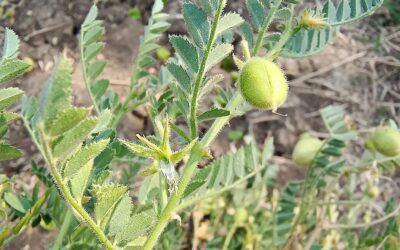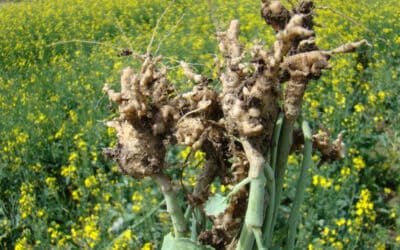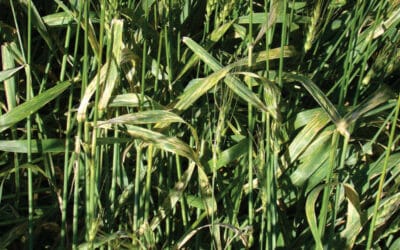Your province wide crop disease outlook for the 2022 growing season.
Future outlooks for any industry can be tricky. Never mind the agriculture industry where many factors can play a role in what transpires over the next year.
It’s important to look at what has developed in the field itself as well as adjacent fields when the crop was last grown. This will typically indicate the typical disease spectrum and what may be needed in the upcoming field season
When it comes to Alberta’s crop outlook for 2022, Michael Harding, crop assurance program lead with the Alberta Government, believes farmers can expect more of the same.
“Farmers will know what disease issues are common in their areas and should scout and assess risk for these regularly-occurring problems in 2022. I’d recommend watching out for bacterial leaf streak on wheat and barley. This is an emerging issue in Alberta and frequently is unnoticed or misdiagnosed.”
He also says clubroot on canola is continuing to spread and is evolving in Alberta — even in the southern portion of the province.
“It is moving much, much slower in southern Alberta, but it is still showing up in new fields from time to time. Early detection is an important management tool. Verticillium stripe on canola is another disease that may be spreading on the prairies and canola producers should be aware of it, and root rots on peas/lentils continue to spread and cause issues.”
2022 Crop Disease Predictions
Predicting crop disease risks is no easy task and can be very challenging because risk will depend on how these three factors — host susceptibility, pathogen virulence and environmental conditions — come together in 2021.
“When susceptible hosts and virulent pathogens come together in a favourable environment, the disease risk is high,” explains Harding. “Conversely, if the host plant is resistant to the pathogen, or if the pathogen is weakly virulent, or if the weather is too cold or too dry, the disease risk will be low.”
He says when trying to predict what farmers can expect, it’s best to look at environmental conditions as weather can be a primary driver of many diseases such as sclerotinia stem rot (canola) and fusarium head blight (wheat/barley) for which genetic resistance is either incomplete or absent, and that are very responsive to precipitation.
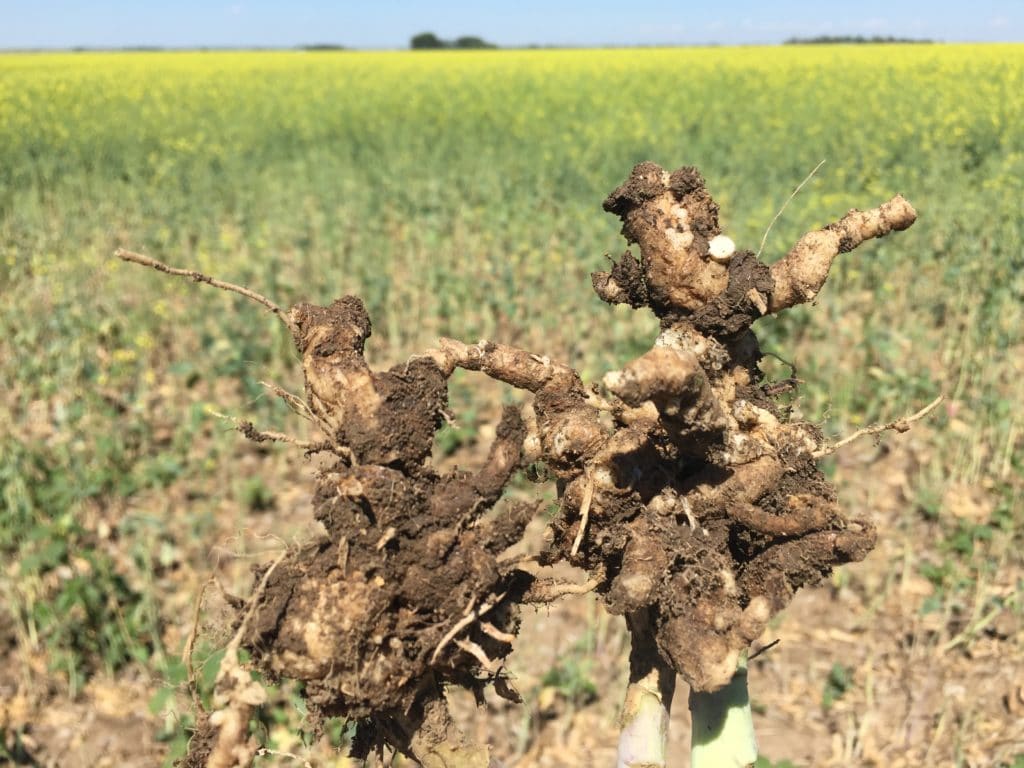
Swollen canola roots result from infection by the clubroot pathogen. The disease can also occur on Brassica weeds such as shepherd’s purse, stinkweed, flixweed, wild mustard, and volunteer canola. Photo: Michael Harding
“So, if we have more precipitation during the summer, we will expect more risk of these diseases. Whereas, if it’s a drier year, we will expect less risk. This would also be true for diseases like mycosphaerella blight on pea, and fungal leaf spots on cereals.”
Syama Chatterton, a plant pathologist at Agriculture and Agri-Food Canada’s (AAFC) Lethbridge Research and Development Centre says root rot should always top-of-mind for pea and lentil crops.
“2021 was an extremely dry year and did not provide ideal conditions for root rot development. However, the largest contributor to risk factors for root rot is the environment in the field when the last pea or lentil crop was grown because of the long-lived resting spores that can survive in soil under harsh conditions. Generally, the last really wet years were in 2020 and 2016.”
She says a five-year break between a pea or lentil crop may not be long enough if root rot issues were found in those fields if they were planted with peas or lentils in 2016.
“If fields were planted with pea or lentil in 2020, a one-year break between pea and lentil crops is not long enough and will increase risk of severe root rot if fields were planted with pea or lentil. However, these were just general trends for the prairies, and producers should assess environmental conditions in their own field or area when making the decision to plant peas or lentil.”
Similarly, she adds that white mould caused by Sclerotinia sclerotiorum wasn’t a big concern in 2021.
“But the resting structures (sclerotia) can also survive long-term in the soil, and a dry year will not be enough to reduce soilborne inoculum by appreciable amounts. For other foliar pathogens — such as Ascochyta blights of chickpea, lentil, and pea — the inoculum is primarily residue-borne with some seed-borne transmission. “Because disease levels were low in 2021, we can expect that there will be lower inoculum levels in crop residue, and this should reduce inoculum loads in 2022. Similarly, seed-borne pathogens should be lower because disease severity was lower in 2021.”
Weather Conditions Affect on Disease
Kelly Turkington, a plant pathologist with AAFC, agrees it can be challenging to predict what disease issue can be expected in the upcoming growing season.
“The main factors influencing risk will be prevailing weather conditions (mainly rainfall), especially in June and July. Weather during these months will be the main driving factor and, thus, it will be important to follow weather information during these key months. For some foliar disease issues — such as leaf spots and rusts in cereals and mycosphaerella/ascochyta in pulses — producers can follow disease development in their crops and use this as an indication of risk and fungicide need.”
However, for other issues such as sclerotinia stem rot in canola and fusarium head blight in cereals, Turkington adds the decision to spray and the application of fungicide needs to be done prior to the appearance of disease.
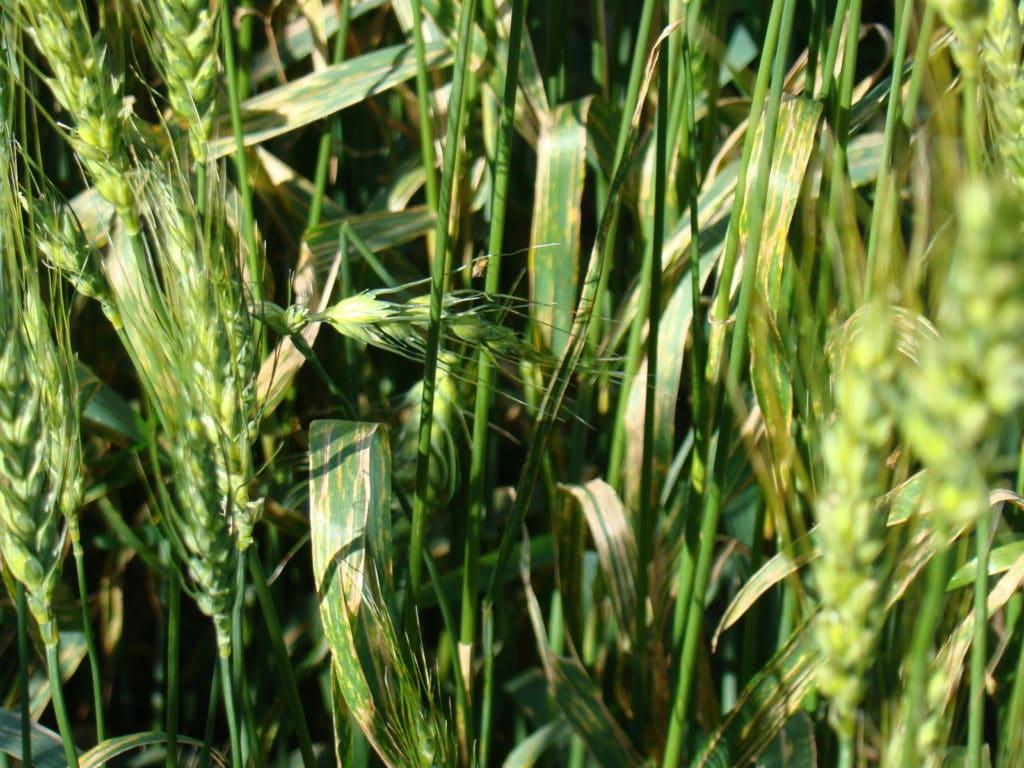
Bacterial leaf streak (BLS) is caused by a bacterial pathogen resulting in elongated chlorotic lesions parallel to leaf veins. Photo: Michael Harding
“So, for these issues, producers will need to follow weather-based risk maps, checklists and other tools to gauge risk and the need for fungicide.”
Harding says another weather-related disease risk is overwintering and long-distance dispersal by wind.
“The best example for this is stripe rust on cereals. In milder winters, with lots of insulating snow cover, the pathogen can overwinter and show up very early in the spring. Alternatively, the pathogen can be blown in from overwintering infections in the Pacific Northwest U.S. The same is true for aster yellows moving from south-to-north via the aster leaf hopper insect vector which can cause serious issues on cereal, canola and horticultural crops.”
Second is the amount of pathogen inoculum from previous years.
“For some areas of the Prairies, we are coming off of a few dry years in a row,” he adds.
“Dry conditions made it difficult for many pathogens to complete life cycles and produce overwintering inoculum. As a result, the potential for disease may have dropped slightly in some regions over the past few years. And finally, growers utilizing genetic resistance traits in the crops they grow will have a much lower risk of seeing disease than those that are growing genetically susceptible cultivars.”
Another factor adding to disease risk in the form of overwintering pathogen inoculum will be growers’ cultural practices and clean seed programs.
“For example, if susceptible host crops are grown in the same field more than once every three to four years, the levels of overwintering inoculum can be maintained or amplified to damaging levels,” explains Harding.
“This is a significant issue for residue-borne diseases like blackleg on canola, cereal leaf spots. Additionally, seed-borne diseases like bacterial leaf streak on cereals, or chocolate spot on faba beans can become severe when infected seed is used.”
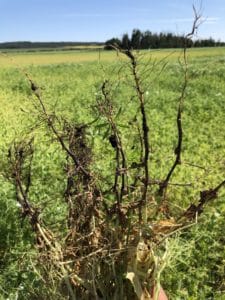
A fungal root infection has caused these pea roots to appear discolored (dark brown/black, rather than a healthy white color), and has caused root pruning which leaves only the main tap root while lateral and fine feeder roots are absent. Photo: Michael Harding
Turkington says as one prepares their upcoming field program, including variety choice, it’ll be important to look at what has developed in the field itself, as well as adjacent fields when the crop was last grown.
“This will indicate your typical disease spectrum and what may be needed in the upcoming field season. This relates to variety choice to target key disease issues experienced previously, whereby the producer can try to use a variety with good levels of resistance. Related to this may be the scenario that the variety a producer wants or needs to grow may be quite susceptible to a particular disease issue and, thus, it may provide an indication of what issues may occur but keeping in mind the impact of seasonal weather conditions.”
Slowing Down Crop Disease in the Field
As for what can be done to slow down or prevent crop disease, there are a number of tools available to growers. These include:
- Cultural practices (crop rotation, weed management, fertility, irrigation).
- Clean seed programs are essential for seed-borne diseases.
- Choosing cultivars with genetic resistance to the most troublesome diseases in your area or farm.
- Timely fungicide applications when the risk of leaf spot, stem rot or foliar blight warrants it. Decision support tools, and disease prediction/forecasts tools can help producers make fungicide application decisions.
“The most important management tool to prevent crop disease is prudent crop rotations,” explains Chatterton.
“The risk of developing devastating roots rot increases when pulses are pushed in a rotation. Once a field has become infested with pathogens, and particularly Aphanomyces euteiches, it can take six to 10-plus years for that field to recover. So, the short-term benefit of short and tight rotations may not outweigh the long-term ramifications, particularly when currently the only viable management strategy for this disease is avoidance of infested fields.”
“Ultimately for many plant diseases it will mainly depend on seasonal weather conditions, especially rainfall in June and July. Dry conditions like we had in 2021 will largely limit disease risk compared to a wetter summer like 2016. It’s also important to note there may be localized weather systems that increase risk as compared to looking at things from a regional or provincial perspective.,” Turkington adds.
Header Photo — Typical symptoms of stripe rust of wheat due to natural inoculum, Beaverlodge Research Farm, Agriculture and Agri-Food Canada, July 13, 2017. Photo: Kelly Turkington
Related Articles
A Total Fusarium Management Strategy for Alberta


